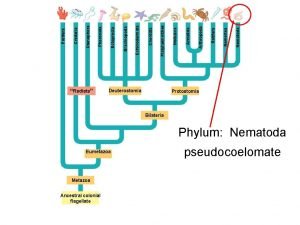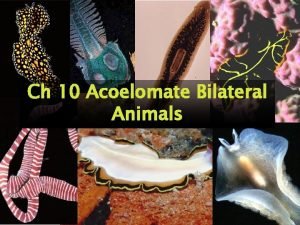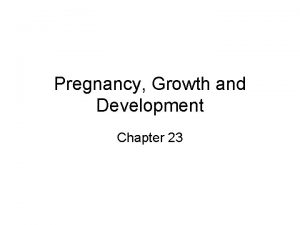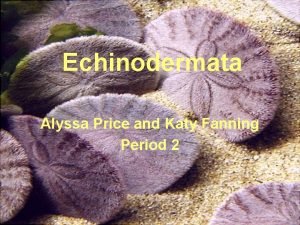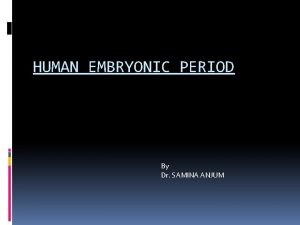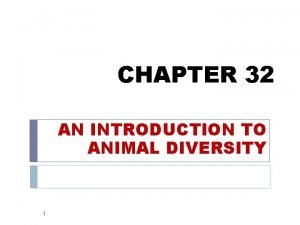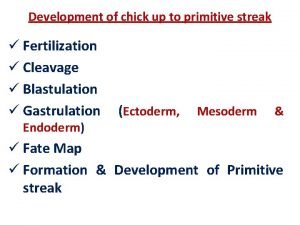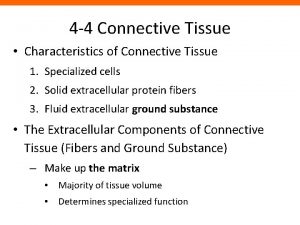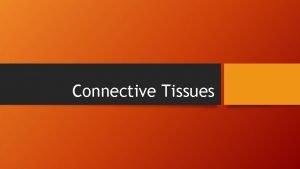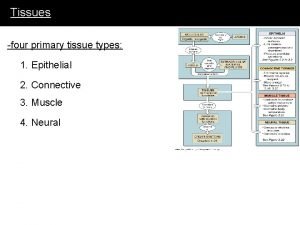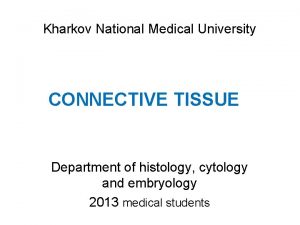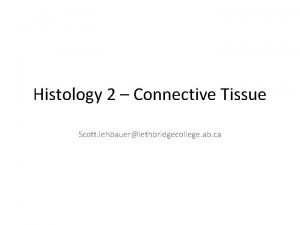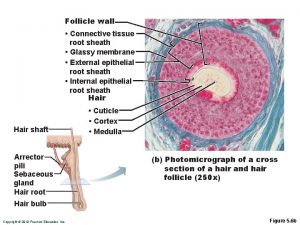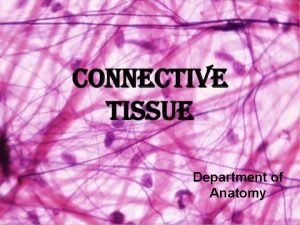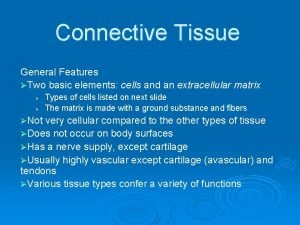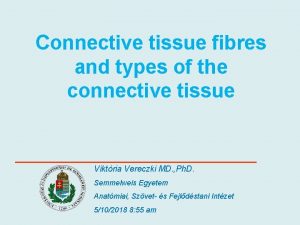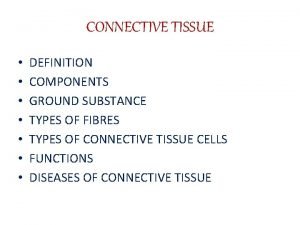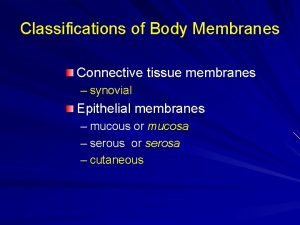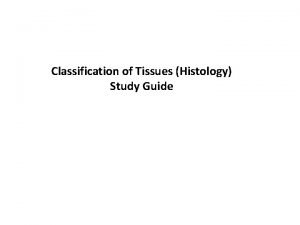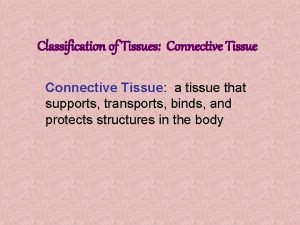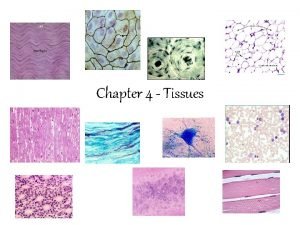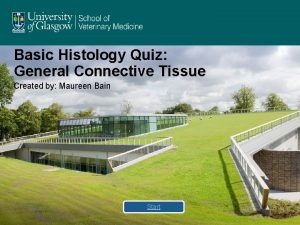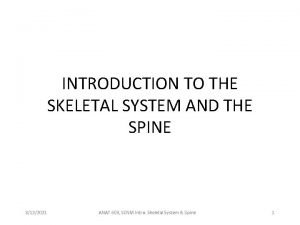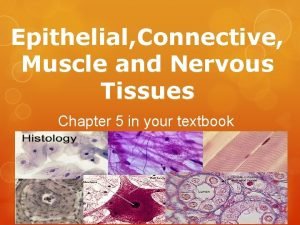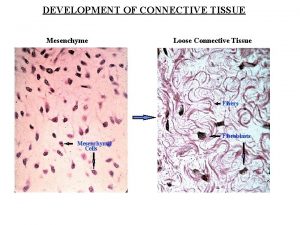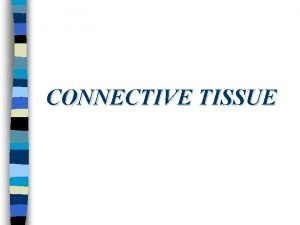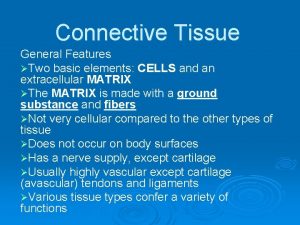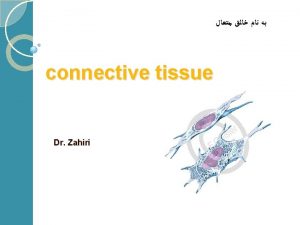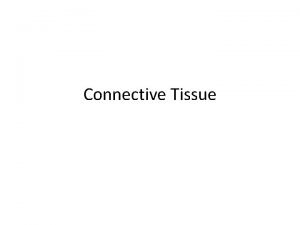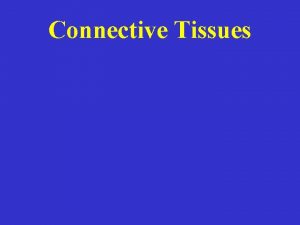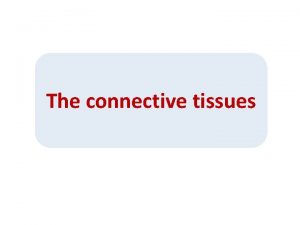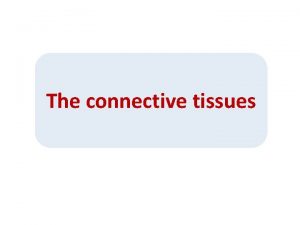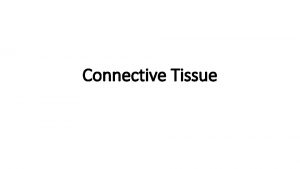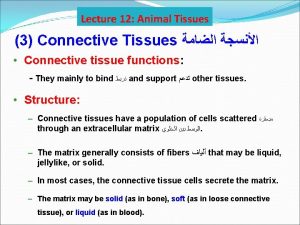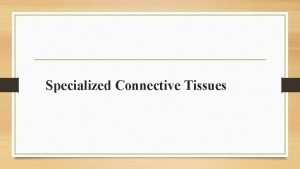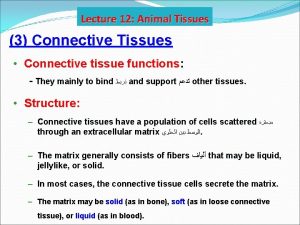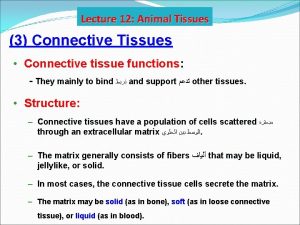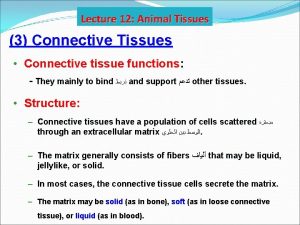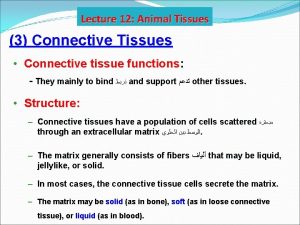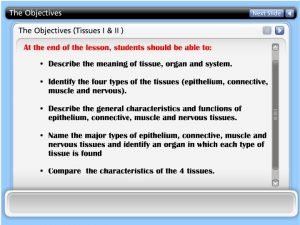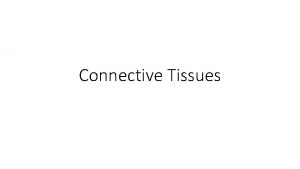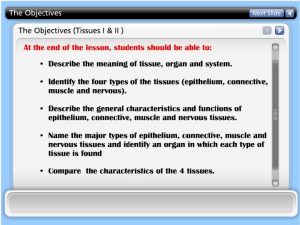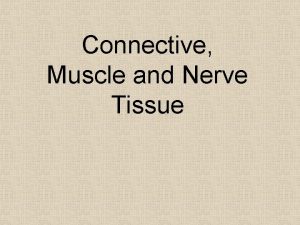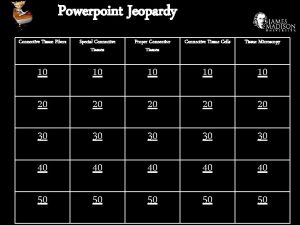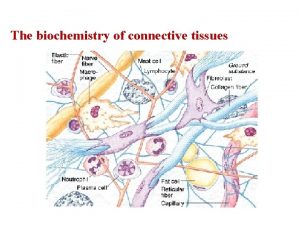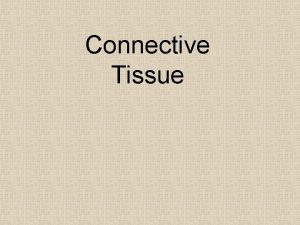TISSUES Connective Tissue the 3 primary germ layers











































- Slides: 43

TISSUES Connective Tissue

the 3 primary germ layers 1. 2. 3. Ectoderm Endoderm Mesoderm These give rise to all the basic tissues of the body

The four types of tissues. Epithelial Connective Muscle Nerve

glandular epithelium & how is it classified A gland is one or more cells that makes and secretes an aqueous fluid Classified by: Site of product release – endocrine or exocrine Relative number of cells forming the gland – unicellular or multicellular

Glandular epithelium – made up of cells that produce secretions

endocrine glands, what they secrete & how do they do it Ductless glands that produce hormones Secretions include amino acids, proteins, glycoproteins, and steroids “Stuff” goes directly into blood

exocrine glands, what they secrete & how do they do it More numerous than endocrine glands Secrete their products onto body surfaces (skin) or into body cavities Examples include mucous, sweat, oil, and salivary glands The only important unicellular gland is the goblet cell “stuff” goes through ducts Sebum from sebaceous gland secretes acid mantle on skin surface to kill bacteria

the major types of connective tissue & some examples Found throughout the body Connective tissue proper, cartilage, bone, & blood All arise from the same stem cell

Endoderm becomes gastrointestinal tract, respiratory tract, endocrine glands and organs Mesoderm becomes bones, cartilage, blood, muscles Ectoderm becomes the nervous system and skin

the general functions of connective tissue Binding and support, protection, insulation, and transportation

the common characteristics of connective tissue Mesenchyme as their common tissue of origin Varying degrees of vascularity Nonliving extracellular matrix, consisting of ground substance and fibers Collagen is the main protein of ct

the major structural elements of connective tissue Ground substance – unstructured material that fills the space between cells Fibers – collagen (fibrous), elastic (elastin), or reticular (fibrous)

types of cells you find in connective tissue & where you find them Fibroblasts Chondroblasts Osteoblasts Hematopoietic stem cells Found in mesenchyme, derived from mesenchymal stem cells


Fibroblast

Chondroblast

Osteoblast

Hematopoietic stem cells


the two types of loose connective tissue proper given & what characterizes them 1. Areolar connective tissue Gel-like matrix with all three connective tissue fibers Fibroblasts, macrophages, mast cells, and some white blood cells Wraps and cushions organs Widely distributed throughout the body

Areolar connective tissue (loose)

Loose connective Tissue Proper 2. Adipose connective tissue Matrix similar to areolar connective tissue with closely packed adipocytes Reserves food stores, insulates against heat loss, and supports and protects Found under skin, around kidneys, within abdomen, and in breasts Local fat deposits serve nutrient needs of highly active organs

Adipose connective tissue (loose)

the two types of dense connective tissue proper & what characterizes them Regular Parallel collagen fibers with a few elastic fibers Major cell type is fibroblasts Attaches muscles to bone or to other muscles, and bone to bone Found in tendons, ligaments, and aponeuroses

Dense Regular (tendons)

Dense connective tissue proper Irregularly arranged collagen fibers with some elastic fibers Major cell type is fibroblasts Withstands tension in many directions providing structural strength Found in the dermis, submucosa of the digestive tract, and fibrous organ capsules

Dense irregular (fibrous dermis)

the 3 different types of cartilage: what they are made of, their functions & where you would find them 1. Hyaline cartilage 2. Elastic cartilage 3. Fibrocartilage

1. Hyaline Cartilage Looks like jelly – does not heal and usually is cut out when injured with hope of gaining muscle to compensate for the loss Chondrocytes lie in lacunae (a small space containing an osteocyte in bone or chondrocyte in cartilage) Supports, reinforces, cushions, and resists compression

Hyaline cartilage Forms the costal cartilage Found in embryonic skeleton, the end of long bones, nose, trachea, and larynx

2. Elastic Cartilage Similar to hyaline cartilage but with more elastic fibers Maintains shape and structure while allowing flexibility Supports external ear (pinna) and the epiglottis

Elastic cartilage has “little eyes”

3. Fibrocartilage Matrix similar to hyaline cartilage but less firm with thick collagen fibers Provides tensile strength and absorbs compression shock Found in intervertebral discs, the pubic symphysis, and in discs of the knee joint

Fibrocartilage

the characteristics & functions of osseous tissue. Hard, calcified matrix with collagen fibers found in bone Osteocytes are found in lacunae and are well vascularized

Osseous Tissue

Osseous Tissue cont’d Supports, protects, and provides levers for muscular action Stores calcium, minerals, and fat Marrow inside bones is the site of hematopoiesis Bones will change shape with pressure: braces/jawbone, tight shoes/bunions, hammer toe

Bone marrow: 2 kinds 1. Red marrow – site of hematopoiesis 2. Yellow marrow – fat (this is why you make soup from bones)

hematopoietic bone marrow of flat bones vertebrae, sternum, ribs, iliac. It represents 4 -6% of body weight. The fatty degeneration of red bone marrow (RBM) (25%) into yellow bone marrow (YBM) (75%) is completed around age 21 years.

Red marrow C hematopoietic tissue forming new blood cells.

Yellow marrow

the characteristics & functions of blood Red (carry O 2, CO 2) and white cells (defense) in a fluid matrix (plasma) Contained within blood vessels Functions in the transport of respiratory gases, nutrients, and wastes

Blood
 Body tissues chapter 3 cells and tissues
Body tissues chapter 3 cells and tissues The 4 tissues
The 4 tissues Body tissues chapter 3 cells and tissues
Body tissues chapter 3 cells and tissues Eisonophil
Eisonophil Chapter 3 cells and tissues
Chapter 3 cells and tissues Triploblasts
Triploblasts Germ layers
Germ layers Germ layers
Germ layers Blastocyst germ layers
Blastocyst germ layers Echinodermata germ layers
Echinodermata germ layers Germ layers of embryo
Germ layers of embryo Germ layers
Germ layers Germ layers
Germ layers Fate of germ layers
Fate of germ layers Specialized connective tissues
Specialized connective tissues Connective tissue function
Connective tissue function Connective tissue
Connective tissue What do all connective tissues have in common
What do all connective tissues have in common Four primary tissue types
Four primary tissue types Nerve tissue description
Nerve tissue description Dense irregular connective tissue
Dense irregular connective tissue Functions of hyaline cartilage
Functions of hyaline cartilage Label the structures of the hair follicle
Label the structures of the hair follicle Tissue type
Tissue type Identify
Identify The dominant fiber type in dense connective tissue is
The dominant fiber type in dense connective tissue is Marfan syndrome symptoms
Marfan syndrome symptoms Ground substance definition
Ground substance definition Reticular fibers definition
Reticular fibers definition 3 components of connective tissue
3 components of connective tissue Serous mucous synovial and cutaneous membranes
Serous mucous synovial and cutaneous membranes Tissue type
Tissue type Where is adipose connective tissue found
Where is adipose connective tissue found Regular connective tissue
Regular connective tissue Connective tissue histology quiz
Connective tissue histology quiz Adipose epithelial tissue
Adipose epithelial tissue Embryonic connective tissue
Embryonic connective tissue Specialized connective tissue blood
Specialized connective tissue blood Skeletal muscle function
Skeletal muscle function Mesenchymal connective tissue
Mesenchymal connective tissue Reticular connective tissue
Reticular connective tissue Areolar connective tissue
Areolar connective tissue Dr zahiri
Dr zahiri Hyaline cartilage cells
Hyaline cartilage cells






